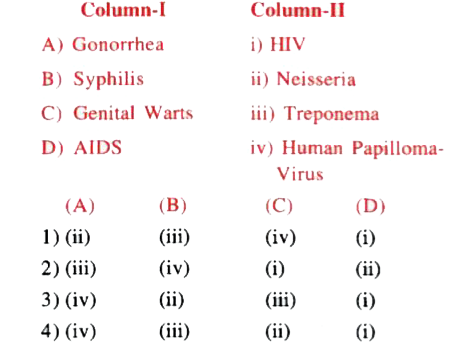Conjuctive tissue in roots is
Cortical tissue
Present between xylem & phloem
Produces lateral roots
Made of sclerenchymatous cells
The correct Answer is:B
Step-by-Step Solution:
1. Understanding Conjunctive Tissue: Conjunctive tissue in roots is a type of tissue that serves as a connecting medium between different types of vascular tissues.
2. Location of Conjunctive Tissue: This tissue is specifically located between the xylem and phloem in the vascular bundles of the root.
3. Identifying the Components: The conjunctive tissue is primarily composed of parenchyma cells, which are living cells that can store food and help in the transport of nutrients.
4. Analyzing the Options:
- Option A: Cortical Tissue: This is incorrect as cortical tissue lies between the epidermis and vascular tissue, not specifically between xylem and phloem.
- Option B: Pericycle: This is also incorrect because the pericycle is the layer from which lateral roots arise, not the conjunctive tissue.
- Option C: Made of Collenchyma: This option is misleading as collenchyma is a type of supportive tissue but does not specifically refer to conjunctive tissue.
5. Conclusion: The conjunctive tissue in roots is correctly identified as the tissue that lies between the xylem and phloem.
Final Answer: Conjunctive tissue in roots is present between xylem and phloem.
---
- Option A: Cortical Tissue: This is incorrect as cortical tissue lies between the epidermis and vascular tissue, not specifically between xylem and phloem.
- Option B: Pericycle: This is also incorrect because the pericycle is the layer from which lateral roots arise, not the conjunctive tissue.
- Option C: Made of Collenchyma: This option is misleading as collenchyma is a type of supportive tissue but does not specifically refer to conjunctive tissue.
Topper's Solved these Questions
- HISTOLOGY AND ANATOMY OF FLOWERING PLANTSBook:AAKASH SERIESChapter:HISTOLOGY AND ANATOMY OF FLOWERING PLANTSExercise:EXERCISE - I (SECONDARY GROWTH)
Explore 45 Videos
- HISTOLOGY AND ANATOMY OF FLOWERING PLANTSBook:AAKASH SERIESChapter:HISTOLOGY AND ANATOMY OF FLOWERING PLANTSExercise:EXERCISE - II
Explore 214 Videos
- HISTOLOGY AND ANATOMY OF FLOWERING PLANTSBook:AAKASH SERIESChapter:HISTOLOGY AND ANATOMY OF FLOWERING PLANTSExercise:EXERCISE - I (THE TISSUES SYSTEMS)
Explore 41 Videos
- ENVIRONMENTAL ISSUESBook:AAKASH SERIESChapter:ENVIRONMENTAL ISSUESExercise:Exercise-III (Previous AIPMT/NEET Questions)
Explore 41 Videos
- HUMAN HEALTH DISEASEBook:AAKASH SERIESChapter:HUMAN HEALTH DISEASEExercise:EXERCISE - III (PREVIOUS AIPMT/NEET QUESTIONS)
Explore 56 Videos
Similar Questions
Dedifferentiation occurs during the formation of
View SolutionHistogen theory was proposed by
View SolutionGuard cells of stomata are very closely associated with
View SolutionWhich of the following in sewage treatment removes suspended solids?
View SolutionMatch the following sexually transmitted diseases (Colum-I) with their causative agent (Column -II) and select the correct option.

View SolutionVascular tissue of monocot root is
View Solutionजड़ में .......... ऊतक अनुपस्थित रहता है ।
View SolutionWhich tissue is not found in roots?
View SolutionTissue present in epiphytic roots _____
View SolutionWhich of the following statement is a conjuction?
View SolutionConjuctive tissue in roots is
View SolutionWhich of the following statement is a conjuction?
View SolutionVelamen is tissue found in roots of :
View SolutionWhat is conjuctive tissue ?
View SolutionVascular tissue of monocot root is
View SolutionName the following tissues. Root-root
View Solution
